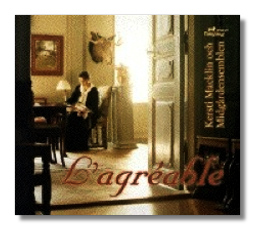
The Internet's Premier Classical Music Source
Related Links
- Latest Reviews
- More Reviews
-
By Composer
-
Collections
DVD & Blu-ray
Books
Concert Reviews
Articles/Interviews
Software
Audio
Search Amazon
Recommended Links
Site News
 CD Review
CD Review
L'agréable

Baroque Music on Nyckelharpa
- Marin Marais: Three Dances
- Thomas Baltzar: Divisions on a Ground
- Michele Mascitti: Trio Sonata in G minor, opus 6 #15
- Karl Ditters von Dittersdorf: Trio for Strings in D
- Georg Philipp Telemann: Concerto in G
- Plus selections from Swedish folklore collections
Kersti Macklin, nyckelharpa
with Midgårdensemblen:
Odd Maad, recorders
Ewa Gammelgård & Maria Hulthén, baroque violins
Henry Gammelgård, baroque viola
Marika Erlandsson & Chrichan Larson, baroque cellos
Ingela Ekström, cembalo
Gustav Bergqvist, bass guitar
Recorded in Falun, Sweden, April - June 1996
Produced by Per-Ulf Allmo
Engineered by Christer Eklund
Tongång AWCD-10 71:22
All the music on this recording is from the Baroque period. Some of it is by more-or-less well-known composers, the rest is from collections of unattributed music recorded on paper during the same period. It is not surprising that "La Folia" – the greatest hit of the eighteenth century – makes more than one appearance.
You are probably wondering about the nyckelharpa. This is a Swedish instrument similar to a viola but played with keys along the broad neck. In addition to three or four bowed strings, the instrument has up to thirteen metal sympathetic strings, like a sitar. It is played on the lap. The nyckelharpa has a sharp, tangy, insistent sound which blends well with the baroque instruments. There is also a certain amount of clicking from the keyboard, especially in the faster passages, which in no way detracts from the charm of the instrument.
Macklin and the backup band keep lively time and exhibit a good understanding of Baroque ornamentation. This may be a unique opportunity to hear music of the Baroque court played on this peasant instrument, as there is apparently no evidence that the nyckelharpa was used in this setting.
The Swedish folk music in this recording includes a set of variations on Foli d'Espagne, taken from the collection made by Gustav Blidström in 1715. This collection documents the music current among the Swedish peasantry at the time. There is no great difference between this folk music and its contemporary through-composed music, as the Allegro of Mascitti's Sonata begins with the same melodic line as La Folia.
In a number of these folk tunes, the melody line is taken by the recorder or doubled by flute and nyckelharpa. In others, the strings provide substantial support. Three of the pieces from the Blidström collection are duets for nyckelharpa and an acoustic bass guitar.
For those readers who are looking for something out of the ordinary along the pathways of the Baroque, this disc is enthusiastically recommended. It makes for very pleasant listening and a few surprises.
Copyright © 1997, Paul Geffen












